Menu
Table of contents
No matter how you look at it: you want to get started yourself. And that's where this article is going to help you, because in 12 simple steps I'll show you how to do an SEO audit yourself.
What is an SEO audit?
The word audit means to check, review or verify. And so with an SEO audit, you're doing a sort of MOT of your organic findability.
It is also called an SEO analysis.
So think of it as a kind of diagnosis of your website / online presence with the goal of becoming more findable. Opinions are divided on the content of an SEO audit, but in my opinion, the following components definitely belong in it:
- Technical check
- On Page SEO check
- Off Page SEO check
- Competitive Analysis
- Keyword
Why is an SEO audit important?
An SEO audit is important because you want to know what could be better about the current situation. Because of course you can write even more content and do even more guest blogging, but if your website's load time is 10 seconds and your website has 500 backlinks from China, you're never going to rank well.
What tools are important in an SEO audit?
By now, there are hundreds of SEO tools on the market and, of course, there are plenty of alternatives to the tools I'm about to mention. But these are the tools I used to conduct the SEO website audit.
Feel free to use a different program, because you happen to have already purchased it or like it better.
- SEMrush
- KWFinder
- SEO Site Check Up
- GT Metrix
- Google Page Speed
- Screaming Frog
- Google Analytics
- Google Search Console
- Google's mobile-friendly test
- Google Structured Data Testing Tool
- Ahrefs
Step 1: Start with a general SEO check
The first thing I always do when I start an SEO process is run the client 's website through SEO Site Check Up. SEO Site Check Up checks your website for the following points:
- Common SEO problems
- Speed optimizations
- Server and security
- Mobile-friendly
- Advanced SEO
As you might actually see, SEO Site Check Up is a kind of SEO audit in itself. It validates the website on many of the points mentioned earlier.
I always start with SEO Site Check Up to identify the biggest SEO problems right away. Like the lack of an SSL certificate, canonicalization problems or other areas of improvement that preferably need to be addressed today.
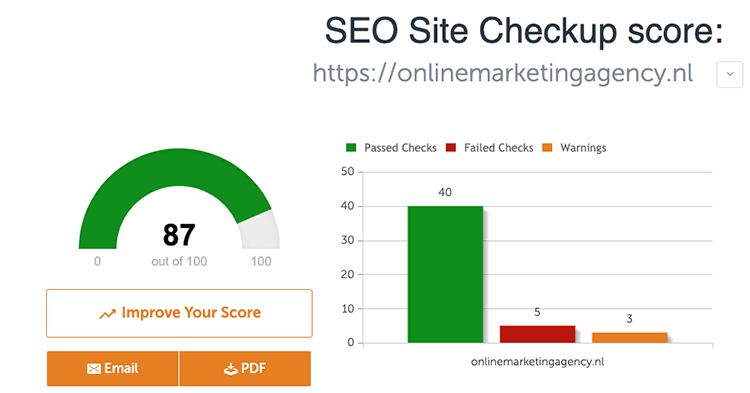
Step 2: Crawl your website for errors with Search Console
Now that we have identified the first most pressing areas for improvement, let's move on to another important step: crawling your website with Google Search Console and SEMrush.
Google Search Console is a tool from Google that gives you control and capabilities over your own indexing in Google. If you don't have Google Search Console yet, I recommend creating it right now:
Tutorial: creating Google Search Console and adding your website correctly
When you click on "Coverage" in Search Console, you will then see all the problems within your website. Think 404s, pages that are on noindex or pages that are blocked by your robots.txt.
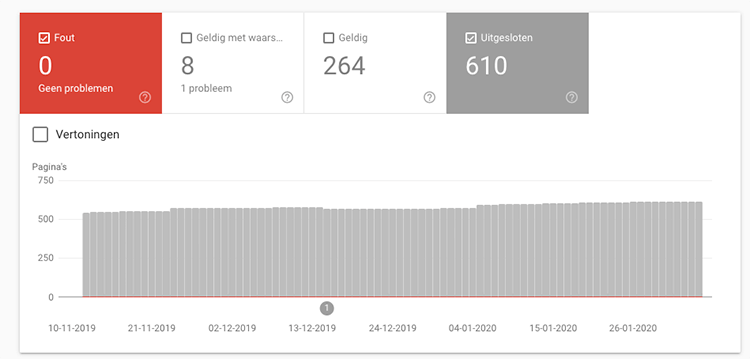
In addition to Google Search Console, I always use SEMrush' s Site Audit feature to analyze and crawl the website.
In fact, SEMrush also looks at small areas of improvement and missing elements. This is something that Google Search Console does not do.
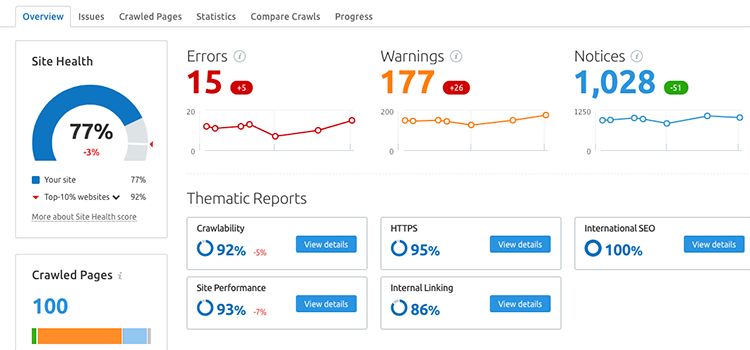
Step 3: Check all On Page SEO elements
If all goes well, I don't need to explain to you that the keyword you want to rank for must be used in the text, in the URL and the meta description, for example.
Those "things" where your keyword should appear, then, are the On Page SEO elements. In other words, the elements that you have influence over within the page. In case you don't know them. These are them:
- URL
- H1
- H2
- Images (name and alt text)
- Meta title
- Meta description
Checking the On Page SEO elements can of course be done manually (which is way too much work), but can also be done with handy SEO tools.
I use SEMrush for that, too. It has a handy tool called the On Page SEO Checker. It tells you very easily what the On Page improvement points are in terms of:
- Strategy
- SERP features
- Content
- Semantics
- Backlinks
- Technology
- User Experience

Tooltip: a tool that I also find incredibly nice to use is Screaming Frog. With this you can also easily figure out all the URLs within your website, determine On Page Elements and much more.
Step 4: Analyze loading speed
That the loading time of your Web site is a ranking factor has long been known. And that a long load time is terribly annoying and causes people to drop out is even longer known.
For analyzing your speed, I recommend using two tools:
- GT Metrix
- Google Page Speed
Both tools are unique in their own way and work completely differently. I am very much a fan of GT Metrix, because it shows you concretely what to do.
For example, consider optimizing images, enabling caching or using minification or by turning off certain features.

Step 5: Make sure your website is mobile-friendly
It completely depends on what industry or niche your business is in, but it could be that 90% of your visitors visit your website via mobile. And since July 1, 2019, Google also indexes mobile-first.
The first thing you can do to test if your website is mobile friendly is to simply test it yourself on different devices. Click through the website, see if everything works and if everything is clear.
If you pass that test, then you can use Google' s Mobile Friendly Test to determine if Google also thinks your website is mobile friendly.

Step 6: Understand the structure of your website
Now that we've covered some of the SEO principles, it's time to tackle the more difficult stuff. And we'll start with the structure of your website.
The structure of a Web site is important for several reasons:
- A website should be easy to use by a visitor and people should be able to click through the site without effort
- Google should easily crawl through the website to find and index all pages
To explain, I have two images for you. One of how to do it:

And one of how not to do it:

The biggest difference? There is a logical layered structure in the first image. The second image is a "mess.
The structure is even more important for web shops than for websites. That has to do with it because there you usually have to deal with many more categories and you want to help Google and visitors find them as well as possible.
Step 7: See if your website is equipped with structured data
And we immediately move on to the next step.
Structured data is highlighting a piece of content to make it more understandable to Google. Consider, for example, reviews, products or recipes.

When we talk about structured data, two things are actually important:
- Does your website feature structured data?
- Is the structured data added correctly and does Google accept it?
You can answer both questions with the Google Structured Data test.
It tells you exactly what structured data is being used, what is currently going well and what is currently not going well.
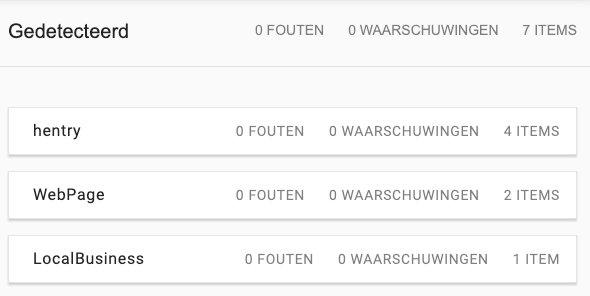
Step 8: Find out which pages rank well (and which do not)
So. We've had the SEO technical stuff. Now it's high time to see which pages rank well and which don't.
We're going to do this by looking at which pages in Google Analytics had a lot of organic visitors.
First, go to the Google Analytics website and log in to the appropriate account.
Then click on "Acquisition" on the left, then "All Traffic," then "Channels.
Then click on "organic search" and just above the table, click on "destination page.
And voila, you get a list of the pages that had the most organic visitors
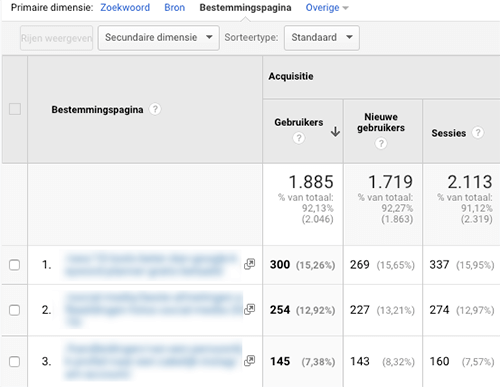
Should you want to know which pages had the least organic visitors? Then click "Users. Then the order of the list will be reversed.
Then a little further down the table, you can also immediately analyze how good the traffic is on that page. For example, do you see a bounce rate of 100%? Then that could mean that people are not finding what they are looking for.
Step 9: For a backlink analysis from
It is unfortunately still true, but backlinks are one of the most important ranking factor within Google. Backlinks can make or break your website.
To perform a backlink analyzer, I mainly use Ahrefs and SEMrush.
During backlink analysis, I mainly look at:
- The number of backlinks
- The number of domains the backlinks come from
- Spamscore
- Anchor tags of the backlinks (and the relationships between the anchor tags)
- Referring IP addresses
- Domain authority
- Page authority
- Ratio of nofollow/dofollow
- Extension of links
- Whether there are bad links among the link profile
Ahrefs has the largest database and shows the most information. Therefore, I use Ahrefs primarily.
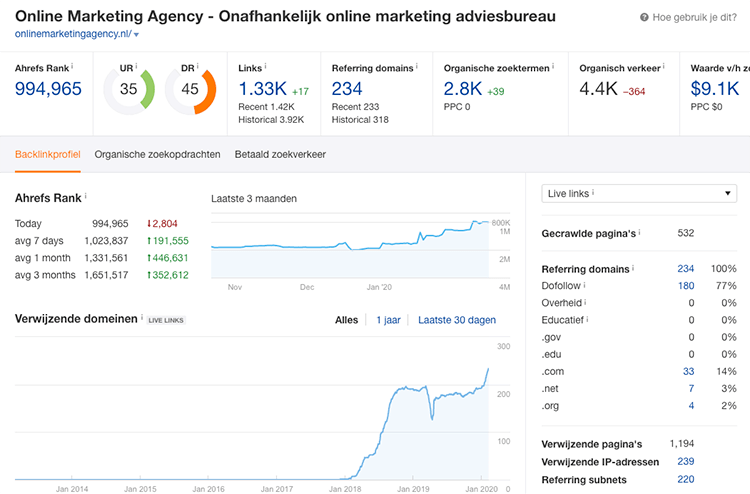
Should I want to go very in-depth and analyze a link profile deeper and better, I mainly use SEMrush.
SEMrush shows just a little more useful information and graphs to provide insight into how well or poorly you are doing. It completely depends on what I want to know or what I want to do to determine which tool I use.
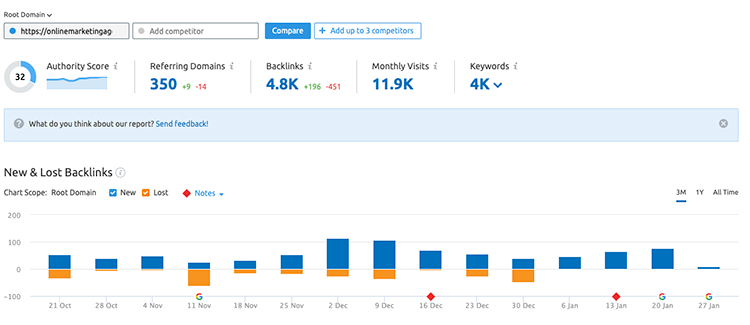
Step 10: Spy on your competitors with a competitive analysis
To rank higher in Google, you need to do one thing above all else: beat your competitors. So it is incredibly important to keep an eye on what your competitor is doing.
What content do they have? What backlinks do they have? How fast is their website?
Those are all things you can easily figure out. In fact, I just explained how you can do that with your own site. So now you can do the same with their website.
When I start analyzing content competition, I look at three components:
- What are the keywords my competitors are being found on?
- What is my competitor's best-scoring content?
- On what keywords is my competitor findable and I am not?
The answer to all three of these questions, Ahrefs gives me.
Determine competitors' keywords
Ahrefs works incredibly simply. First, you need to enter your competitor's domain press enter.

Then click on "Organic Search Terms" on the left side of the row and you will see a list of all the keywords your competitor is being found on. You can then select by country, position, volume, difficulty and more.

Best scoring content from competitors
Finding out competitors' top-ranking content is as easy as determining organic search terms.
In the left-hand row within Ahrefs, click not on "organic search terms" but on "top pages," and you'll see the top-ranking content for the domain you entered.
Search terms that your competitor is findable on and you are not
You can easily figure this out with Ahrefs as well. Click on "content gap" in the row on the left. Then enter your competitor's URL and at the bottom your domain.
Then also choose whether you want to see only keywords that are in the top 10 (or outside them as well) and then click "Show search terms.
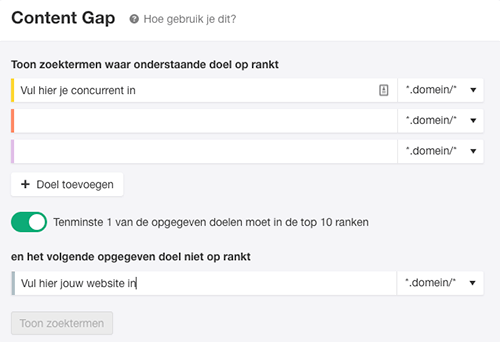
Step 11: The next step
So. In an extremely short time, you've done an analysis of your website. What I recommend you do is track your keywords. You can do this too with SEMrush.
Why I advise you to do that? Then you keep a finger on the pulse and know when you are dropping or rising in Google. You can then quickly analyze and make adjustments as needed.
The next step is to start working on the areas of improvement within your website. Note, chances are you're going to need help with this.
But should you still want to try it yourself and have questions about something? Then chances are I've written a blog about that. If even that doesn't help you, feel free to contact me.
Good luck!
This article was written February 15, 2020 and updated July 27, 2023.
What is an SEO audit?
An SEO audit is a type of check where you check how your website's search engine optimization is doing. In other words, you check the current state of your website's findability in Google and in which areas you could improve to achieve higher rankings.
What does an SEO audit checklist consist of?
When doing an SEO audit, you can follow a checklist to make sure you don't miss anything. You can argue about what all should be on that checklist. In any case, we always recommend that you check the technology, content and off-page SEO (link building) as well as include a competition and keyword analysis!
Are there any SEO audit tools?
There are a lot of SEO tools you can use to perform an audit! Think SEMRush, Ahrefs, Moz or SERanking. But don't underestimate the power of free tools like Screaming Frog, GT Metrix, PageSpeed Insights Google Search Console, Google Analytics and the structured data testing tool either. Above all, use what you like ... or make a mix!











Written by: Daniel Kuipers
Daniel is the founder of Online Marketing Agency. He constantly scours the Internet for the latest gadgets and tactics and blogs about them in understandable language. Well, sometimes.